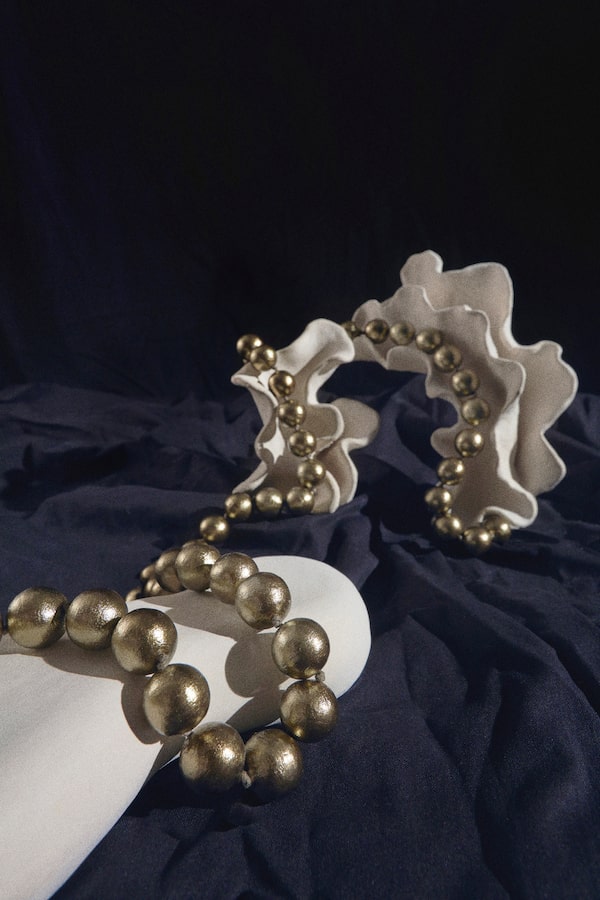
Necklace, US$348 at Tory Burch (toryburch.com).Saty + Pratha/The Globe and Mail
The most memorable scene in Spencer, Pablo Larrain’s 2021 biopic of Diana, Princess of Wales, is when the psychodrama reaches a dramatic crescendo at a Royal Family dinner. As her fairy tale crumbles around her, the princess, played by Kristen Stewart, frustratingly rips off her necklace and its enormous pearls go flying into her soup. She then frantically spoons them into her mouth – and swallows them.
This season, the fashion world seems equally hungry for gobstopper pearls, which proliferate as accessories, embellishments and whole garments. There are Wilma Flintstone-sized necklaces at Dolce & Gabbana and Versace. At Givenchy, pearls appear as cloud-like clusters on knuckle rings and are strung into ropes that are woven into a flapper dress. Erdem studs hems, necklines, suiting and even leather opera gloves with shimmering domed pearls in the manner typical of garments worn in traditional royal portraits.
Fall fashion’s pearl proportions are so emphatic they’re almost kitsch and feel like a defiant departure from the prevailing cultural meaning where a strand of pearls is associated with demure debutantes and feminine propriety. Granted, the meaning behind the orbs has swung between posh and punk for a while.
The penchant for pearls can be traced back to antiquity, when the mystique around the only gem to come from a living creature carried varied symbolism. Ancient Egypt associated pearls with Isis, the goddess of life and healing. Greek mythology suggests they were formed from droplets spilled as Aphrodite emerged from the sea. In Chinese legend, pearls fell from the jaws of warring dragons.

(From left) Numbering necklace, $185; Miu Miu necklace, $1,650 at Ssense (ssense.com).Saty + Pratha/The Globe and Mail
“It’s really the ultimate classicism of fine pearls that invites subversion – and has always done, at various points through history,” says jewellery historian Vivienne Becker, author of The Pearl Necklace. In renaissance court life, for example, Becker says that wearing rare and precious pearls was a form of propaganda, “a way of saying my nation, my realm is more powerful than yours because I’ve got more pearls on.” Using so many of them in a way that emphasizes their size (and fakeness) on the runways today is a way of making another type of statement. “I think it’s that anti-establishment mood that’s happening – a bit of rebellion combined with the changing views of femininity today,” Becker says. Musicians Pharrell Williams and Harry Styles, who have both been photographed in their own strands, would likely agree.
For designer Simone Rocha, who plays their luminosity against organza, tulle and, this season, knit balaclavas, pearls are a brand signature that adorn everything from gowns and crowns to the jewel-encrusted eye makeup on her fall runway. “They’re so ‘old lady,’ but I love to reinterpret them,” the Irish designer has said. Sometimes they’re abstracted and supersized for their sculptural quality such as in an oversized pearl evening bag. Elsewhere, Rocha preserves their stereotypical daintiness but deploys it in unexpected details, like the trim of knee socks.

Erdem pearl flower earrings, $436 through erdem.com.Saty + Pratha/The Globe and Mail
Nadia Gohar, an Egyptian-born multimedia artist based in Toronto, is drawn to pearls by a similar appreciation for their duality. She and sister Laila, a New York food designer, recently launched a tableware collection called Gohar World. It applies their personal clothing style to dressing up a table. “And adding pearls to that mixes it up a bit,” Gohar says.
Pearls abound in a collection that encompasses striped poplin tablecloths (complete with button plackets and collars), linen coasters, hand-carved mother-of-pearl cutlery and Battenberg lace doilies edged with organic freshwater pearls. “When you think of pearls, it’s usually of something so elegant, passed down, and your grandmother,” Gohar says.
The 2022 Pinterest Predicts report, an analysis of the social media platform’s search data, anticipated the Pearlcore trend not only in fashion but in the iridescence that’s dominating beauty and home decor products. The rise can, in part, be attributed to Netflix’s blockbuster Regency drama Bridgerton, where more is more when it comes to both the racy plot and the costume department’s fanciful use of pearls in chokers and towering wigs.
Becker says that, when trying to understand the pearl’s place in contemporary fashion, it’s worth remembering Coco Chanel’s groundbreaking mix of genuine and simulated pearls (she began creating bijou en toc – or fake jewellery – to accompany her seasonal collections in 1924). “Basically, she parodied the great pearl necklaces she’d seen when she was young being worn by the Belle Epoque socialites,” Becker says. “For her, they were a symbol of a society from which she was excluded. I think she was quoted as saying that they turned up their noses at her and this was her way of getting back.”
By debunking their preciousness and stripping pearls of their established social status, Chanel transformed them into fashion statements. “Symbols of a different kind of power,” says Becker. “The power of the modern woman.”
Fashion styling by Nadia Pizzimenti. Prop styling and clay sculptures by Kristen Lim Tung.